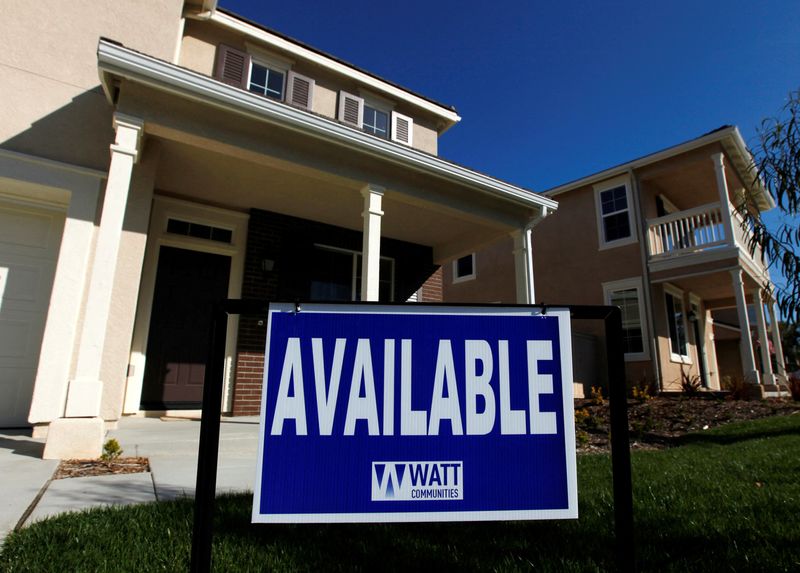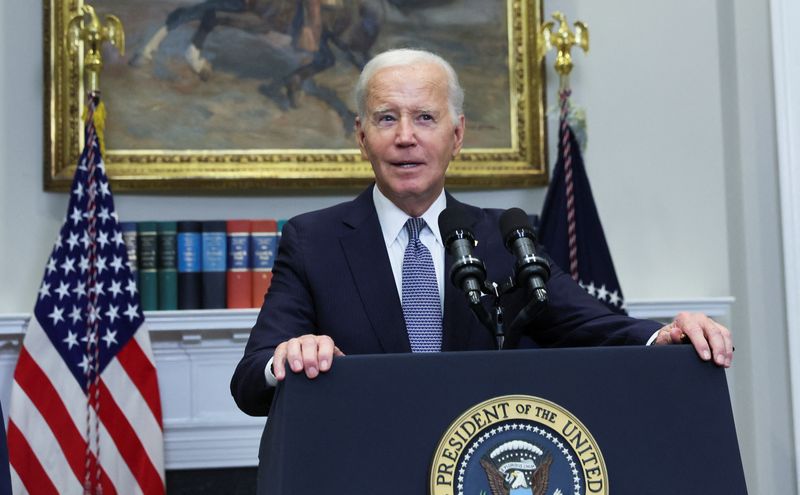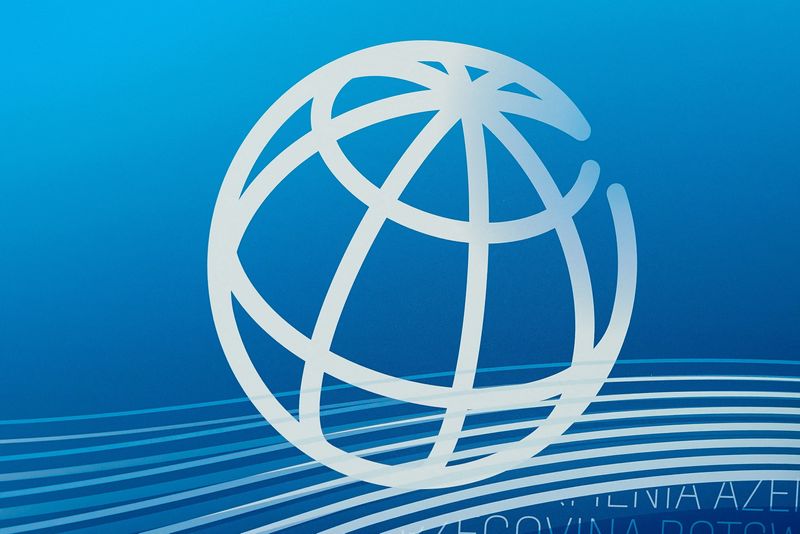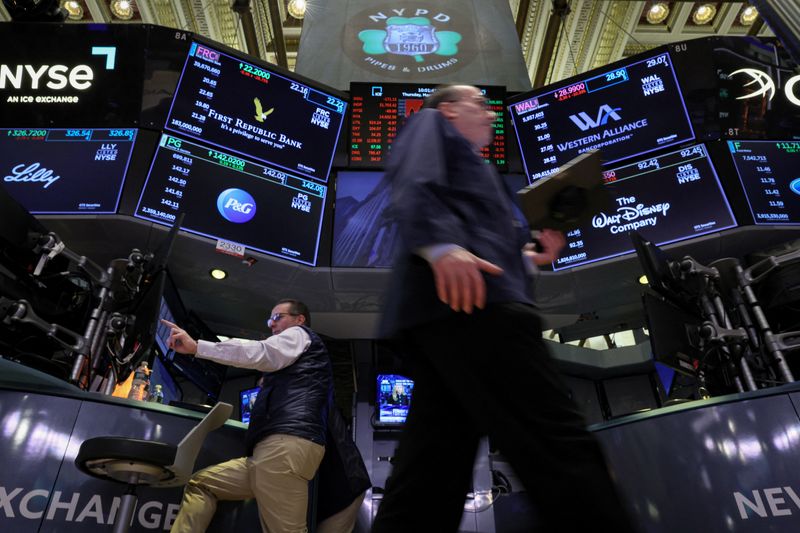Select Language

BEIJING (Reuters) -China's imports and exports fell much faster than expected in July, threatening growth prospects in the world's second-largest economy and heightening pressure for the government to provide fresh stimulus to prop up demand.
Imports dropped 12.4% in July year-on-year, customs data showed on Tuesday, missing a forecast fall of 5% in a Reuters poll. Exports contracted 14.5%, steeper than an expected 12.5% decline and the previous month's 12.4% fall.
Inbound shipments saw their biggest decline since January, when COVID infections shut shops and factories, crushing domestic demand.
The economy grew at a sluggish pace in the second quarter as demand weakened at home and abroad, prompting top leaders to promise further policy support and analysts to downgrade their growth forecasts for the year.
Poor imports and exports are the latest sign that third quarter growth could slow further, with construction, manufacturing and services activity, foreign direct investment, and industrial profits all weakening.
"Most measures of export orders point to a much greater decline in foreign demand than has so far been reflected in the customs data," said Julian Evans-Pritchard, head of China Economics at Capital Economics. "And the near-term outlook for consumer spending in developed economies remains challenging, with many still at risk of recessions later this year, albeit mild ones."
China's yuan hit a three-week low and Asian stocks turned weaker after the data.
The state planner last week said stimulus would be forthcoming, but investors have so far been underwhelmed by proposals to expand consumption in the automobile, real estate and services sectors.
Beijing is looking for ways to boost domestic consumption without easing monetary policy too much lest it triggers large capital outflows as other major economies raise interest rates to tame soaring inflation.
That is affecting economic activity in the rest of Asia. South Korean exports to China fell 25.1% in July from a year earlier, the sharpest decline in three months.
China's trade surplus grew by $80.6 billion, beating a forecast of $70.6 billion in the poll.

(Reuters) -Electric-vehicle parts supplier Proterra filed for Chapter 11 bankruptcy protection on Monday, making it the latest company to go belly up in an industry grappling with supply chain constraints, slowing demand and a funding drought.
The move comes weeks after Lordstown Motors filed for bankruptcy protection and put itself up for sale after failing to resolve a dispute over a promised investment from Foxconn.
Proterra, whose shares nearly halved in value after the bell, listed its assets and liabilities in the range of $500 million to $1 billion. The company had a market value of $362 million as of last close.
In January 2021, Proterra was valued at $1.6 billion, including debt, in a merger deal with a blank-check firm.
"We have faced various market and macroeconomic headwinds that have impacted our ability to efficiently scale," CEO Gareth Joyce said in a statement.
Proterra, which makes electric buses as well as battery packs, said it intends to continue to operate in the ordinary course of business. It plans to file the customary motions with the bankruptcy court to use existing capital to fund operations.
The company earlier this year announced plans for more job cuts and said it will combine electric bus and battery production in South Carolina as it looks to trim costs.

By Safiyah Riddle
(Reuters) - The share of U.S. consumers who believe it is a bad time to buy a home reached the highest level in at least 13 years in July, according to a survey released on Monday, as the supply of available properties remains scarce and home prices appear to have stopped cooling.
The portion of U.S. consumers saying now is a "bad time to buy" a new home increased by 4 percentage points in July to 82%, according to a report released Monday by Fannie Mae, the highest level since the mortgage finance giant began conducting the survey in 2010.
Consumers' outlook also appears to have taken a hit, with a net 17% of respondents expecting price increases in the next 12 months, the highest percentage in over a year.
The grim perception of the housing market comes as home costs appear to have hit a floor after downward price pressure from the Federal Reserve's 525 basis points worth of interest rate hikes since March 2022.
Persistently high home-buying costs are in large part due to limited housing stock, which has remained at historically low levels. Many homeowners are now unwilling to buy a new home that would require more expensive financing compared to mortgage costs locked in before the Fed started raising rates.
Willingness to sell was unchanged in July, according to the survey, with 64% of respondents indicating that now was a good time to sell - unchanged from the month prior.
Not all was pessimistic in the report, however, as confidence in the labor market and expected decreases in future mortgage rates pushed the overall Home Purchase Sentiment Index to 66.8, up 4 points year over year and 0.8 points from June.
"While consumers are reporting confidence in the components related to their personal financial situations, it’s unlikely we'll see housing sentiment catch up to other broader economic confidence measures until there is meaningful improvement to home purchase affordability," said Doug Duncan, Fannie Mae senior vice president and chief economist.

By Nate Raymond
(Reuters) -A federal appeals court on Monday blocked the Biden administration from proceeding with another piece of its student debt relief agenda, a rule that would make it easier for people who are defrauded by their schools to have their loans forgiven.
At the request of a group representing for-profit colleges, the New Orleans-based 5th U.S. Circuit Court of Appeals prevented the rule from taking effect pending the outcome of an appeal to be heard in November.
The three-judge panel gave no reason for granting the emergency injunction sought by the trade group, Career Colleges and Schools of Texas (CCST), which is appealing a lower-court judge's decision not to block the U.S. Department of Education's rule.
CCST sued in February after the Education Department in October finalized a new rule changing a program that allows students to seek debt relief if their schools mislead them.
The new rule offers greater grounds for borrowers to get debt relief in cases of fraud and establishes a procedure for the Education Department to forgive debt for groups of students at schools where this occurred.
The rule is separate from Biden's more sweeping student debt relief plan. The Supreme Court in June blocked his administration from canceling $430 billion in student loan debt for 43 million borrowers. The Democratic president has since announced plans to provide relief for student loan borrowers using a different approach.
A spokesperson for the Education Department in a statement said it was reviewing Monday's order, adding that it "won't back down in our efforts to take on predatory colleges, provide relief to borrowers who have been cheated or had their school close, and hold institutions accountable for deceptive schemes."
Students who have received debt forgiveness through the program on deceptive loans have attended for-profit colleges including Corinthian Colleges and ITT (NYSE:ITT) Technical Institute.
CCST called the rule an unlawful and unconstitutional plan designed "to accomplish massive loan forgiveness for borrowers and to reallocate the correspondingly massive financial liability to institutions of higher education."
The panel's three judges -- Edith Jones, Kyle Duncan and Cory Wilson -- were all appointed by Republican presidents.

By Lucy Craymer
WELLINGTON (Reuters) - Public debt in most Pacific countries is expected to fall in the next 12 months as countries move towards the gradual unwinding of COVID-19 stimulus and the fiscal situation improves, according to a World Bank report released on Tuesday.
“In line with fiscal consolidation efforts, public debt is projected to decline during 2023- 2024 across the Pacific (except in Solomon Islands and Federated States of Micronesia),” the Pacific Economic Update said on Tuesday.
Debt has surged in the region since 2019 as the tourism-dependent economies were hit by COVID border closures, trade was hurt by logistical challenges and weather events caused damage. Countries took on more debt to implement support and stimulus packages. This was particularly notable in tourist- dependent countries such as Fiji, Palau and Vanuatu.
The World Bank has previously said six Pacific countries - Kiribati, Republic of the Marshall Islands, Federated States of Micronesia, Samoa, Tonga and Tuvalu - are at a high risk of debt distress.
However, Tuesday’s report added that as the fiscal deficit widens in Solomon Islands and FSM, the governments are expected to increase borrowing to meet the financing gap — increasing the public debt.
It added that in terms of economic output, most Pacific countries - except Palau, Samoa and Solomon Islands - are projected to hit pre-pandemic gross domestic product levels by 2024.
“In contrast, some countries where fishing license revenue is a dominant contributor to income, such as Kiribati and Republic of the Marshall Islands (RMI), surpassed pre-pandemic levels in 2021 because the fishing sector was less impacted by border closures,” it noted.
The report added that risks remained including uncertainty in global commodity price movements and geopolitical tensions serve as downside risks to the Pacific’s economic recovery.
“Given the region’s vulnerability to disasters, climate change is a persistent major underlying risk,” it added.

By Kevin Buckland and Brigid Riley
TOKYO (Reuters) - Japanese government bond yields fell from multi-month highs on Monday, mirroring a sharp retreat in their U.S. peers at the end of last week after data showed U.S. jobs growth had cooled.
The 30-year JGB yield fell 2 basis points (bps) to 1.595%, after reaching 1.63% in the previous session for the first time since mid-January. The Finance Ministry's auction of about 900 billion yen ($6.33 billion) of the tenor on Tuesday will be closely watched as a litmus test of demand in the sector.
The 20-year yield declined 1.5 bps to 1.32%. It hit 1.355% on Friday, a level last seen at the start of February.
The 10-year JGB yield slid 2 bps to 0.62%. On Thursday it had risen to the highest since January 2014 at 0.655% as the market continued to seek an equilibrium level between the Bank of Japan's official policy ceiling of 0.5% under yield curve control (YCC) and the new de-facto limit at 1% following last month's surprise policy tweak.
Minutes of that meeting released in the Tokyo morning offered little in the way of fresh clues for traders.
Equivalent U.S. Treasury yields were little changed at around 4.06% in Tokyo trading after plunging some 14 bps on Friday from a nine-month high above 4.2% reached earlier that session.
Investors are closely monitoring how the Bank of Japan conducts its bond-purchase operations for hints on a comfortable level for the 10-year yield.
The central bank's focus thus far on buying of maturities up to 10 years may buff the attractiveness of the 30-year bonds at Tuesday's auction, said Takafumi Yamawaki, head of Japan fixed-income research at J.P. Morgan Securities.
"The BOJ has not shown the intention to control superlong yields," Yamawaki said, adding that on an absolute basis, "life insurers think the 30-year JGB yield at this moment is quite attractive."
At the shorter end on Monday, two-year JGB yield fell 0.5 bp to 0.015%, while the five-year yield declined 1 bp to 0.20%.
Benchmark 10-year JGB futures closed 0.24 yen higher at 146.60, rebounding from Friday's nearly five-month low of 146.24.
($1 = 142.0800 yen)

By Leika Kihara
TOKYO (Reuters) -The Bank of Japan debated growing prospects of sustained inflation at their July meeting with one board member saying wages and prices could keep rising at a pace "not seen in the past," according to a summary of opinions released on Monday.
While the members stressed the need to keep ultra-easy monetary policy, the upbeat view on the inflation outlook suggests they are now more convinced that conditions for phasing out stimulus could fall in place.
"More firms have started to consider wage hikes for next fiscal year and beyond. Japan is expected to see a new phase where wages and services prices continue to increase," according to one opinion shown in the summary.
"The recent wage hikes and pass-through of cost increases by firms have a pent-up aspect, in that these moves had been suppressed for nearly three decades. Therefore, wages and selling prices could continue to rise at a pace that has not been seen in the past," another opinion showed.
At the July meeting, the BOJ kept its yield curve control (YCC) targets unchanged but took steps to allow long-term interest rates to rise more freely in line with increasing inflation and economic growth.
Governor Kazuo Ueda said the decision was a pre-emptive move against the risk of rising inflation pushing up long-term bond yields, and heightening volatility in financial markets.
With high uncertainty over the outlook, as well as both "upside and downside risks" to inflation, it was appropriate to make YCC flexible at this stage, several members said, according to the summary.
"If prices and inflation expectations continue to heighten, the effects of monetary easing will strengthen. On the other hand, strictly capping the 10-year bond yield at 0.5% could affect bond market function and market volatility," one opinion showed.
While some saw the need to make YCC more flexible as a preventive measure against future risks, one member said sustained achievement of 2% inflation was already in sight.
"Achievement of 2% inflation in a sustainable and stable manner seems to have clearly come in sight. In order to continue with monetary easing smoothly until an exit, the Bank should allow greater flexibility in its conduct of yield curve control," the member was quoted as saying.
Under YCC, the BOJ guides short-term interest rates at -0.1% and the 10-year bond yield around 0% as part of efforts to prop up growth and sustainably achieve its 2% inflation target.
It also sets an allowance band of 50 basis point around the 10-year yield target. The BOJ nominally kept the band unchanged last month but said it would now allow the 10-year yield to rise to as much as 1.0%.
Japan's core consumer inflation stayed above the central bank's 2% target in June for the 15th straight month, as firms kept passing on higher import costs to households.
The BOJ has said it needs to maintain ultra-low rates until robust domestic demand and higher wages replace cost-push factors as key drivers of price gains, and keep inflation sustainably around its target.

By Jamie McGeever
(Reuters) - A look at the day ahead in Asian markets from Jamie McGeever, financial markets columnist.
A clutch of top-tier Chinese economic data, second-quarter growth figures from Indonesia and the Philippines, and an Indian interest rate decision are the main events in Asia this week, with markets highly sensitive to rising global bond yields.
The Nasdaq, S&P 500 and MSCI World index last week all registered their biggest weekly losses since March, and the MSCI Asia ex-Japan index's 2.3% fall was its biggest in six weeks.
Driving the deterioration in risk appetite is the surge in global bond yields, especially U.S. market-based borrowing costs as the long end of the Treasury curve came under intense selling pressure.
The U.S. yield curve steepened by 20-30 basis points last week - the biggest steepening since March - and the steepening of the 2-year/30-year yield curve by 30 basis points was one of the biggest weekly moves in over a decade.
Perhaps counterintuitively, from a stock market perspective at least, this is partly due to the resilience of the U.S. economy. The 'soft landing' or even 'no landing' narrative is gathering momentum, and JP Morgan on Friday became the latest Wall Street bank to remove or delay their U.S. recession call.
U.S. fiscal worries are also growing, however, and the Bank of Japan's recent 'yield curve control' surprise has lifted Japanese bond yields. All else equal, financial conditions are tightening, and despite a strong U.S. earnings season scorecard, stocks are feeling the squeeze.
Asia's corporate earnings season picks up this week, with Alibaba (NYSE:BABA) the standout in a trickle from China, and Sony (NYSE:SONY) and Softbank (OTC:SFTBY) among a flood of big names from Japan.
Several potential market-moving data releases and events in Asia are also due, as well U.S. consumer price inflation for July. Economists polled by Reuters expect the annual rate to rise to 3.3% from 3.0%.
On the economic front, the main focus will be Chinese trade, lending, producer price and consumer inflation data. Investors will be hoping for signs that deflationary pressures and weakness in import and export activity this year are finally abating.
If not, the pressure on Beijing to inject substantial stimulus into the economy will only intensify. On its own, cutting banks' reserve requirement ratios will not be enough.
The Reserve Bank of India, meanwhile, is expected to keep its benchmark repo rate on hold at 6.50% on Thursday and hold it there through March 2024.
Monday's calendar in Asia is fairly light, with Indonesian Q2 GDP and Thai inflation for July the main releases. Indonesia's economy is expected to have grown 3.72% in Q2, rebounding from a 0.92% contraction in Q1, but slow slightly on an annual basis.
Here are key developments that could provide more direction to markets on Monday:
- Indonesia GDP (Q2)
- Thailand CPI inflation (July)
- China FX reserves (July)
(By Jamie McGeever; Editing by Diane Craft)

By Suban Abdulla
LONDON (Reuters) - British employers reduced the number of new permanent staff they hired through recruitment agencies by the most since mid 2020 last month due to concerns about the economic outlook, adding to signs that the market is becoming tougher for job seekers.
A gauge of permanent staff hiring by the Recruitment and Employment Confederation and accountants KPMG fell to 42.4, the lowest since the 34.3 in June 2020 when the country was in lockdown due to the COVID-19 pandemic.
The survey's measure of temporary staff hiring, which often rises when employers are cautious about the outlook, in July showed the weakest growth in nine months - partly because more workers were looking for the security of permanent roles.
Neil Carberry, chief executive of REC, said the jobs market remained "fairly robust" despite the slowdown in permanent placements.
"To some extend this is normalisation as the post-pandemic boom abates, but it is also driven by uncertainty," he said.
While starting pay for new permanent staff rose sharply by pre-pandemic standards, the rate of wage growth was the lowest since April 2021, REC said.
Claire Warnes, partner of skills and productivity at KPMG UK, said competition for skilled workers and cost of living pressures were keeping starting salaries high.
Monday's survey chimed with other indicators showing the labour market is loosening, welcome news for the Bank of England which raised interest rates for the 14th meeting in a row to 5.25% last week and has been concerned about high wage growth.
Official data showed unemployment rose to 4% in the three months to May, a 16-month high, although annual wage growth remained at a record high of 7.3% in cash terms.
Separate figures from accountants BDO showed rising interest rates, tough trading conditions and weak demand hit hiring intentions and business confidence across services and manufacturing sectors.
BDO's employment index fell for the first time in six months in July and its optimism gauge declined for the first time in four months.
REC said the availability of both temporary and permanent workers to fill jobs hit the highest since December 2020.

Investing.com -- All eyes will be on the U.S. in the coming week as inflation data is released. GDP data out of the U.K. will show how the economy is holding up in the face of continued rate hikes. Data out of China could point to deflation risks in the world’s number two economy. Here’s what you need to know to start your week.
U.S. inflation data
The U.S. is to release July inflation data on Thursday which will show whether price pressures are trending down and if markets are correct in believing that the Fed is close to ending its aggressive cycle of interest rate hikes.
Lower numbers would make it more likely that Fed policymakers will hold off raising interest rates at their upcoming September meeting after a quarter-percentage-point hike last month.
On Friday, the U.S. is to release July PPI data, with core producer prices expected to rise by 2.3% from a year earlier.
Investors will also get to hear from several Fed officials during the coming week with Philadelphia Fed President Patrick Harker, Atlanta Fed President Raphael Bostic and Fed Governor Michelle Bowman making appearances.
Pause in stock market rally
Wall Street closed broadly lower on Friday and weekly percentage declines for the S&P and Nasdaq were the biggest since March as some investors locked in profits after five months of gains.
The near-term trajectory for equities could depend on whether Thursday’s inflation data shows consumer prices moderating. Investors are also closely watching the path of Treasury yields, which rattled markets in recent days by rising to fresh year highs following a downgrade of the U.S. credit rating by Fitch.
Rising yields on Treasuries, viewed as among the world's safest investments because they are backed by the U.S. government, can dampen demand for stocks.
Friday’s U.S. employment data showed that while job growth continued at a moderate pace in July wage growth remained faster than expected, fueling worries that the Fed may keep rates higher for longer.
U.K. GDP
The U.K. is to release second quarter GDP data on Friday which is expected to tick fractionally higher, indicating that the overall economy remains all but stagnant. In May, it shrank less than expected, having almost stalled in the prior two months.
The Bank of England raised U.K. rates to a 15-year-high of 5.25% last Thursday, its 14th back-to-back increase, and warned that borrowing costs were likely to stay high for some time.
British inflation hit a 41-year high of 11.1% last October and has fallen more slowly than elsewhere, standing at 7.9% in June, the highest of any major economy.
Deputy Governor Ben Broadbent said keeping relatively high rates over an extended period was key for cutting inflation, even as the BoE sees the economy growing only minimally in the coming years.
China inflation
China is to release trade figures on Tuesday followed by July inflation data on Wednesday, which is expected to show a drop in consumer prices, amid concerns over the outlook for the world’s second largest economy.
China’s economy rebounded strongly in the first quarter after strict pandemic-era curbs were suddenly removed late last year, but the recovery has faltered in recent months as demand at home and abroad weakens.
Authorities have rolled out a series of policy measures in recent weeks to support the flagging recovery, though details have been scant, and investors are expecting more to come.
Eurozone data
In the Eurozone, Germany is to release data on industrial production on Monday. The report is expected to point to a decline amid a slowdown in global demand, particularly from China.
The German economy stagnated in the second quarter of 2023, missing forecasts for modest growth, as weak purchasing power, higher interest rates and low factory order books all weighed on the euro zone's largest economy.
--Reuters contributed to this report

